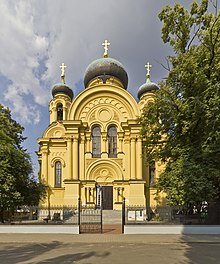Cathedral of St. Mary Magdalene, Warsaw
| Metropolitan Cathedral of the Holy and Equal-to-the-Apostles Mary Magdalene in Warsaw | |
|---|---|
| Sobór metropolitalny Świętej Równej Apostołom Marii Magdaleny w Warszawie |
|

The Metropolitan Cathedral in Warsaw.
|
|
| 52°15′17″N 21°02′00″E / 52.254808°N 21.033208°ECoordinates: 52°15′17″N 21°02′00″E / 52.254808°N 21.033208°E | |
| Location | Warsaw |
| Country | Poland |
| Denomination | Polish Orthodox Church |
| Website | http://katedra.org.pl/ |
| Architecture | |
| Architect(s) | Nikolai Sychev |
| Style | Russian Revival |
| Groundbreaking | 1867 |
| Completed | 1869 |
The Metropolitan Cathedral of the Holy and Equal-to-the-Apostles Mary Magdalene is a Polish Orthodox cathedral, located at al. Solidarności 52 in Warsaw.
It opened in 1869, serving the needs of a growing community of Russians settling in the area of present-day Praga Północ. During the Second Republic, the cathedral became one of two free-standing Orthodox churches in Warsaw, which were not destroyed or adapted for other purposes.
It is the main Polish Orthodox Church. The cathedral is also the cathedral for the Diocese of Warsaw-Bielsk.
It was entered into the register of monuments on July 1, 1965 with No. 741.
Serious development of Praga, which took place in the second half of the 19th century, combined with the general development of Warsaw, meant thousands of people settled in the area. The incoming settlers were dominated by Russians and citizens of the eastern area of the Russian occupation, professing Orthodoxy. This was also the professed religion of the soldiers of the two Russian garrisons, which were located in Praga. In total, across the whole of Praga, Orthodoxy constituted ten percent of all residents. This population was forced to use a church located on the other side of the Vistula river, and there were repeated calls for the bishop of Warsaw and Ioannicius (Ioann Semyonovich Gorski - Archbishop of the Russian church) to undertake the construction of a new church. In November 1865, the governor of the Polish Kingdom Friedrich Wilhelm Rembert von Berg granted consent for the formation of a committee to oversee the construction of the church. Two years later, the bishop announced the launch of preparatory work.
The church Building Committee was founded by Prince Vladimir Cherkassky and General Yevgenii Rozhnov, for which the construction of the church at Praga was also an answer to the real needs of the population and an opportunity to build it in a strategic part of the city (opposite the Vilnius train station) to provide a long lasting sign that Warsaw belonged to the Russian Empire. In the words of Rozhnov, the church was another way to consolidate Russian rule. After its completion, General Rozhnov and the director of the works, Colonel Palitsyn, received state awards.
...
Wikipedia
